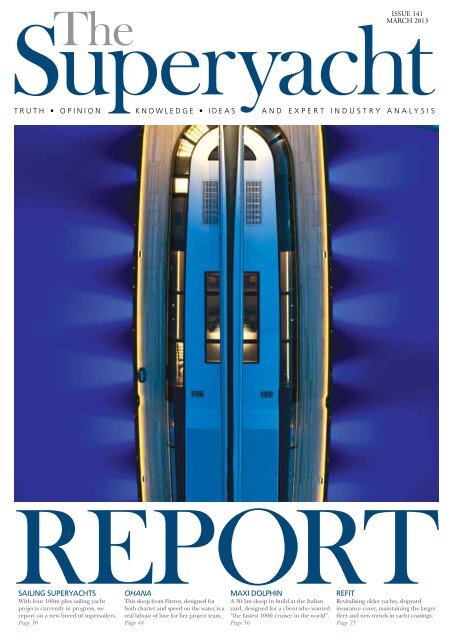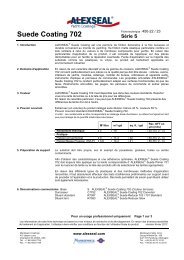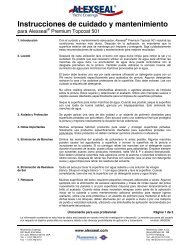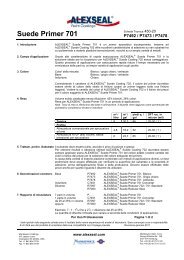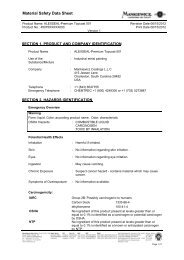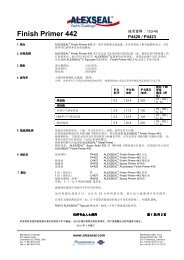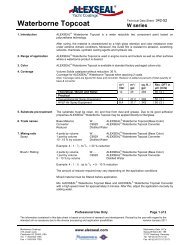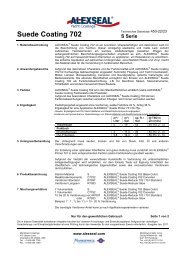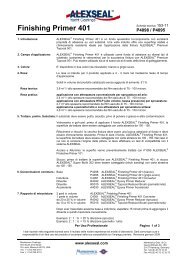Surfaces & Coatings - Alexseal Yacht Coatings
Surfaces & Coatings - Alexseal Yacht Coatings
Surfaces & Coatings - Alexseal Yacht Coatings
You also want an ePaper? Increase the reach of your titles
YUMPU automatically turns print PDFs into web optimized ePapers that Google loves.
surfaces &<strong>Coatings</strong>What’s Trendingin 2013“A ship is always referred to as ‘she’ because it costs so much to keep onein paint and powder.“ So said US Fleet Admiral Chester William Nimitz,but the emphasis now is increasingly being placed on reducing costs aswell as offering new and unique finishes to today’s owners. TSR asked across-section of companies within this market sector to comment on thetrends they are seeing in paint design and the use of innovative solutionsfor the superyachts of tomorrow.THE SUPERYACHT REPORT | ISSUE 141 97
or sheds, reducing significant time and costs at buildstage. Much of the appeal is that the owner can alsobe as daring as he likes because the vinyl can bereversed and reapplied in another colour. It mightalso be that the owner just wants to sell the boat onand restore it to its former glory by removing theprotective layer.We are careful to say that it is very much vinylworking with paint, as there is a place for both on asuperyacht – in new build, refit or giving an olderyacht a facelift.Peter KwartengSenior partner, Topcoat <strong>Yacht</strong> GroupThe truth about exploring new trends in paint designand innovative types of coating for future vesselsis not going to solve the fact that almost everyoneblames paint manufacturers for the reactions anddiscoloration in most white paints some months afterapplication.<strong>Yacht</strong> painting, in my opinion, is the most difficultpart of all the works involved in building a yacht,because it is the shine that the owner sees when hecomes aboard. It could be possible to switch from thepresent-day coating systems to special finishes in mattand vinyl, but both systems, in my opinion, will be toocostly, especially to discard the old spray guns andreplace them with new ones in the case of the vinyl.As for matt finish, a black matt finish looksbeautiful on yachts and it will reduce the heat thatglossy black paint absorbs. Vinyl paint for vesselsof 30m+ will be the most difficult if that is thedirection that paint is going. Vinyl paint is a waterbasedpaint, which has its own set of advantagesand disadvantages. To avoid disasters using vinyl,one needs to prepare the painting surface well, aswith all paint processes. As water-based paint is alsocalled latex paint, it has a binder which is dissolvedin water. This means it is less toxic, and the toolscan be cleaned with plain water. Being a water-basedpaint, compared with oil based, it is also fasterdrying. Oil-based paints needs a specific solvent toclean the tools, which makes using oil-based paintsexpensive. However, vinyl paint, compared withwater-based paint, is not an eco-friendly paint. Oneof the advantages of vinyl paint is that it soaks in thesurface it is painted over; this means it binds wellto the surface and you don’t need to apply two ormore coats of vinyl paint, a single coat is enough.This means painting with vinyl paint is faster andcost-effective and lasts longer. However, the paint hasto be completely removed if it is to be painted againand it is very hard to sand.Andreas LeontsinisDirector, Mega Marine GroupNewly implemented marine environmentalregulations have forced boat builders to producea greener and more eco-friendly product seekingto lower a product’s volatile organic compounds(VOCs). For the marine coatings industry, the ideaQuality Controlmade in GermanySolving yourcoating problemS․ Quality Management․ Surface Inspection․ Coating Optimisation․ Corrosion Protection․ Monitoring․ Project Development․ Construction Advice / Refit․ Coachingwww.wrede-consulting.deinfo@wrede-consulting.detel +49 (0)40 4135 2820HAMbuRg - bARCelOnA - PAlMA De MAllORCAConsultants and Paint Surveyors since 1999
yacht surfaces & coatings trendsInterior Coating Systems from International ®So, it’s only paint?of developing a coating that is greener andwill outlast its current version in durability,life expectancy, aesthetic capabilities andcost is the major and on-going challenge.The type of coating that has seen themost innovation to date is the bottompaints or anti-fouling paints used onthe underwater hulls of the vessels. Theeventual goal of all bottom systems is toeliminate the growth of fouling, whichincludes algae, slime, grass, and barnacles,and to increase the vessel’s performance.The ideal bottom system is one that keepsall marine growth from attaching to theunderwater hull.Underwater hull coatings arebeing developed constantlyand require an incredibleamount of time, research anddevelopmental costs to bringto market.However, up to now, what has made antifoulingswork are the toxins used in thematrix of the paint and have included suchpoisonous chemicals as tributyltin (TBT),copper, creosote, arsenic, mercury, DDT,zinc, silica, magnesium and aluminium,just to name a few. Today’s products haveeliminated most of the aforementionedtoxins and use various combinations ofcuprous oxide and biocides like Econea ® .These combinations do not eliminatemarine growth entirely, but they doprovide a more environmentally friendlyproduct, which helps to increase efficiencyfor a while. These products are selfpolishingor ablative, and must be recoatedevery year or two in order for them towork.About 20 years ago, the development offoul-release systems started the next waveof underwater hull coatings. Their use inthe last eight to 10 years has been on therise, especially with the cost of fuel soaringat an all-time high. Foul-release coatingsprovide a smooth, non-toxic surface thatmakes adhesion of marine growth difficultand with the slightest movement of thevessel the hulls clean themselves and haveproven to last upward of six years on asingle system and provide fuel efficiencyduring the system’s life expectancy.The increase in the vessel’s propulsionefficiency leads to fuel savings and areduction of emissions of greenhousegases, helping the vessel to meet one ofIMO’s newly implemented regulationsin 2013, the Ship Energy EfficiencyManagement Plan (SEEMP).Underwater hull coatings are beingdeveloped constantly and require anincredible amount of time, research anddevelopmental costs to bring to market.Their costs continue to rise, but at leastthese new coatings continue to contributeto the vessel’s fuel efficiency and emissionreductions. Keep your attention focused –this industry will continue to make a hugeimpact on the boating world.Ritvan MetsoManaging director, Thraki <strong>Yacht</strong>Painting<strong>Yacht</strong>ing by its very nature is a nichemarket, and weird colours, vinyls andspecial-effect coatings are another nichewithin it; we are certainly seeing sometrends towards this. Will we find moreowners who want to pay extra for this‘speciality’? Probably. Are we ready forthat? In my opinion, not really. It iscertainly necessary to count the numberof yards that have the infrastructureand know-how to get involved with suchchallenges – there may be three to four atmost.First of all, we should not forget that alot of the new builds delivered are enteringrefit yards with warranty issues only ashort time after their departure from theyard – the problems are commonly relatedto fairing, and on some occasions thetopcoats are not performing as expected.While this basic problem is still an issueare we ready to attempt something morespecial?Applying a matt colour or a vinyl on ahull is definitely interesting, eye catchingand also environmentally beneficial, butwhat does it mean practically? From anapplicator’s point of view, while you can dothis on a car with one sprayer only, when itcomes to a hull on an 85m, you may need10 instead in order to apply it properlywithout ending up with overspray anddust. Ease of repair is also a major issue;when it starts to peel away at the edges,for example, it would be a nightmare toperform a partial repair (the joints arevisible even in cars).I am aware that our industry is all aboutspeciality, and although our market isconservative, there is a trend towardssuch special coatings. The industryneeds to establish a good understandingof the practicality of these coatings,predominantly by the yards, so they don’tpromise miracles to owners before they
are ready. When/if this trend reachesa maturation of understanding andexpectation then we, as applicators, mustinvent techniques combined with intensivetraining so that we can continue to deliverquality on today’s coatings.Tripp NelsonSales and marketing director,<strong>Alexseal</strong> <strong>Yacht</strong> <strong>Coatings</strong>Mankiewicz <strong>Coatings</strong> (the parent companyof <strong>Alexseal</strong> <strong>Yacht</strong> <strong>Coatings</strong>) has seen atrend of yacht finish enquiries followingthe automotive and aerospace markets interms of colour, special effects and design.In today’s high-end automotive market,matt finishes on cars such as BMW havedrawn yacht owners to request these uniquefinishes on their yachts. We saw the sametrend toward metallic finishes. Owners see aunique finish they like and want to duplicateit on their yacht.The significantly larger paintsurfaces of a 30m yacht createunique challenges when tryingto apply and repair metallic,matt or other special finishes.The significantly larger paint surfacesof a 30m yacht create unique challengeswhen trying to apply and repair metallic,matt or other special finishes. It isimportant to recognise the downsideof using these finishes and to thereforemanage the expectations of both ownersand applicators. For example, a matt finishmust be applied to a hard tapeline thatcannot be polished. Polishing a matt finishwill make it a gloss finish. Matt finishesalso become challenging from the effectsof daily use. Fenders, placed on the hull toprotect the yacht, will rub or ‘polish’ sheeninto a matt finish.Repairing unique finishes on a yacht mayalso create challenges. While automobilerepairs involve painting an entire smallpanel, yacht repairs involve painting only aportion of a much larger panel. Blendingunique finishes during a yacht repair cancreate visual differences and thereforerequire more break lines to minimisepainting a portion of a panel.Another trend in automobiles ischrome finishes. Chrome finishes maywork on reflective surfaces and even onthe Mercedes Formula 1 car. However,chrome must be applied using steam in avacuum-sealed environment, a technologythat is not yet available for large-yachtapplications.Each yacht is unique and the yacht’sexterior styling is the first expression ofthat uniqueness. Its paint finish can also beunique as long as all involved understand thetechnology being used. Metallic and mattfinishes may turn heads at the marina, butif durability and reparability are the priority,nothing beats a simple, high gloss whitefinish.Marcus ReynoldsMegayacht brand manager, Jotun<strong>Coatings</strong>In the last few years we have seen bothdesigners and owners following theautomotive fashion trends with metalliccolours and pearlescent finishes, which canbe difficult to apply and achieve a finishthat all parties will accept and be happywith. Matt finishes again are a similar trendcoming from the automotive market withsome of the latest high-quality cars, suchas matt grey McLaren MP4-12C and mattblack Porsche etc, and we have reactedto this trend by developing a mattingagent that can be added to Megagloss HGtopcoat.We are seeing a trend of standardyacht solid colours but with a slight twist– customers requesting special variationson a colour, enabling them to have theirown individual or bespoke registeredcolour shade. This ensures that their yachtis different from the neighbouring boatand they know their yacht paint colour is‘special’.Another advancement is silyl acrylate,using hydrolysis as its polishing mechanism.This is recognised as today’s most advancedself-smoothing and self-polishing antifoulingtechnology. The whole paint filmis smoothed away throughout its life,preventing fouling at a consistent ratefrom start to finish, therefore reducing theroughness of the hull and also providingoutstanding protection against algae andslime.There are new ideas of using heatabsorbingpigments, and insulatinginterior coatings, especially for use on verydark coloured yacht hulls that regularlysail in very hot climates (the Caribbean,Persian Gulf, etc.). This reduction of heattransfer within the yacht could reducethe demand on air-conditioning units,generators and so on, saving fuel andtherefore helping to reduce the yacht’scarbon footprint as well as being better forour environment in the long run.Cut solvent emissions by 50% – Lloyds Surface Spread of Flame certifiedInterior Finish 770 is a high performancepolyurethane satin finish. Suitable for all areasof a yacht interior where a high gloss systemmay not be desirable. The uniform finish alsomakes it suitable for deckheads. Available inwhite and white (RAL 9003).Interior Finish 750 comes in 4 RAL matchedshades and provides a high gloss, high opacityfinish that is tough, chemically resistant andeasy to clean. Interior Finish 750 is particularlysuited for use in engine rooms.Interior Primer 860 delivers a long-lasting,high performance anticorrosive coating in alow odour formulation, which is quick-dryingand has extended over-coating intervals. It issuitable for use in all areas of a yacht’s interior,including wet areas such as bilges and is alight weight alternative to polyester flowcoat –increasing fuel savings.Visit us at yachtpaint.com and let’s discuss our passion for your business. Our World is Water, International and the AkzoNobel logo are trademarks of AkzoNobel. © AkzoNobel 2013.
yacht surfaces & coatings trendsRupert SavageManaging director, Rolling StockCoating a vessel is a very labour-intensive and expensiveprocess – it is, however, what gives the yacht its professionalshine and bling and makes it stand out from the rest. Overrecent years, clients are demanding not only increasinglyhigher quality but also different and more exotic finishes– everything from metallic, pearlescent, chrome, matt,satin, full gloss to other textured and special effects likethose created with vinyls. These coatings need to be appliedprofessionally and efficiently as well as being easy to maintainand have longevity.We have to adapt to the market’s demands and gainexperience in all the technology available. Every type ofcoating and application method has its pros and cons; thequestion is, what is the most influential factor?Robotic filler application machines have been tried andtested with different levels of success to reduce the fairingtime in new builds. The problem is that they are mostlysuited to simple hull forms in a production line and struggleto cope with the complexities of superstructures and the factthat almost every yacht is different.Metallic, pearlescent, chrome and matt finishes, if appliedwith suitable skill, can look incredibly striking – the problemwill always remain that these finishes are very difficult tomaintain and effectively repair. Certain specialised polishesare increasingly popular as an excellent option to maintainand prolong the painted surface, but this will always be atemporary solution.Vinyl wraps are increasingly more sophisticated and canbe applied relatively quickly to a multitude of smaller areas,tenders, toys, dashboards, etc., to create an assortment ofdifferent effects and colours. They are restricted, however, bythe width of the roll (unsuitable for large areas) and do notoffer the same depth of gloss or distinction of image as a paint.Despite these options, all of which have merits and remainimportant, a professionally applied solid coloured yachtpaint system remains both the most popular and practicalcoating solution. In recent years, paint has been changingits composition to reduce its negative environmental impactyet still produces the greatest depth of gloss, distinction ofimage, reparability and durability.Marc SchulzCEO, FL <strong>Coatings</strong>Some 25 years ago I was astonished to meet someone whoput clear liquid on his windscreen and told me that fromnow on he wouldn’t need any wipers. Eight weeks later hewas disappointed that the coating had vanished.This year, and certainly in the coming years, we will facethe same problems if we do not take responsibility for whatwe do. For years the innovation process for coating materialshas been stagnant. The ‘big players’ only look at the massmarket. The colours are still the same and for some playerseven metallic is not standard.This opens niche markets for some small companies in thissegment. The main risk is that many decision makers don’tknow much about coatings. If these niche companies seethe market as an opportunity for ‘quick money’ the wholesector will suffer as a result. I’ve seen some products at theMonaco <strong>Yacht</strong> Show, for example a five-micron nanotechcoating (which is a very well-marketed product), where someowners will soon be standing in front of their yachts lookingas disappointed as the guy 25 years ago.Nanotechnology started an invisible revolution. It needshighly specialised companies to provide the market with safe,tested, certified and reliable solutions.<strong>Coatings</strong> that look like real steel or fully transparent antifoulingwill approach the market in 2013. As in the past, thesmall players will deliver the real innovations while the globalplayers will ask how we pulled the rabbit out of the hat!Chris TooleGlobal brand manager, AwlgripBefore considering the coatings trends, we believe thereare three drivers that will influence these: firstly regulatoryand legislative requirements, or changes, that will propelthe trend towards certain coating types as, simply speaking,they will be the only compliant ones available. These will bethe ‘unseen innovations and trends’ of 2013, as most enduserswill not even know they have occurred. The seconddriver is the need to increase the competitiveness of acoating. <strong>Coatings</strong> that reduce work/cycle time and increaseproductivity will directly affect which coatings trend. Finally,enabling builders and applicators to replicate a designer’svision in the real world will be key in 2013 (if it wasn’talready!). It goes without saying that any products that fit thisthird driver will also have to comply with the first two.A tough challenge, but then who said coatings were easy?Clear coatings for wood, in all manner ofgloss levels, will always be trendy and itwon’t be any different in 2013. <strong>Coatings</strong>that allow a designer to use the naturalbeauty of wood yet don’t swallow upa large part of the coating schedule arealways going to do well. So, on to the trends: we believe that those interior coatings/technologies that satisfy the above three drivers, whileallowing designers to exercise their creative side and don’tcreate havoc for the builders, will see a surge this year. Withinthis area there are several coatings types.Clear coatings for wood, in all manner of gloss levels,will always be trendy and it won’t be any different in 2013.<strong>Coatings</strong> that allow a designer to use the natural beautyof wood yet don’t swallow up a large part of the coatingschedule are always going to do well. Textured finishes are definitely more in demand andare going to become a common sight on yachts. As manyconsumer items such as mobile phones, tablets and musicplayers evolve, so has the need to make them feel moreluxurious and premium. Many would be surprised to knowthat the soft touch or suede effect on their mobile coversis actually produced by adding different additives to liquidpaint! These coatings will allow the designer to incorporate aluxurious visual and tactile aspect to the design/vision, withthe benefits to the owner and crew of low maintenance andeasy-to-clean surfaces.104 THE SUPERYACHT REPORT | ISSUE 141
yacht surfaces & coatings trendsFinally, faux finishes; we often envisage coatings as merelyliquid paint, yet over the course of 2013 coatings in theform of films will appear. These high-tech films can bedigitally printed upon to deliver a finish that will matchreal timbers used within the cabin yet will not burn innormal atmospheres and have been certified for SOLASrequirements. As such, they meet LY2 and PYC and theirextremely low calorific value can significantly reducethe calorific loading in a cabin, allowing more freedomelsewhere to use combustible materials in a design. Withthe ability to have finishes such as wood-grain effect, marbleeffect, chrome and other bright metals, 3D effect finishesand digital print on film – which means any image canbe printed on to the film – designers will really be able toexpress themselves!Giles TruscottSales manager, Tribos <strong>Coatings</strong>Now, more than ever, presentation and appearances matter.It’s this fact that means surface coatings remains one of thehot topics in our industry, and as such the protection andprolonged enhancement of surfaces is also a key issue. Tocontinually deliver on the exacting standards, it is essential todevelop, research, innovate and improve.Our industry demands the very best, but no longer hasbottomless pockets. Paint companies and the applicators oftheir products are always under pressure to deliver the veryhighest standards. With an increasing numbers of ownerslooking to refit instead of buying new, this is more criticalthan ever.Customers are no longer satisfied bytheir paint just lasting longer; what theyreally want is for it to look like new forlonger with minimal effort.Customers are no longer satisfied by their paint just lastinglonger; what they really want is for it to look like new forlonger with minimal effort. More and more, we are findingthat owners are demanding better and that means addingadditional protection and enhancement to deliver on theirhigh expectations.We don’t see this in just our superyacht business, butalso throughout our automotive and aviation businesses aswell. Across the board, the bar is now considerably higher,resulting in less effective products dropping out of themarket. The continual drive for better, faster and cheapernever ceases; innovation and responding to this demandremain the key to success.Kay WredeFounder, Wrede ConsultingBoat buyers and the yacht market are certainly changingpreferences at the moment, with the trend towardseverything that is unusual – and that means even for yachtsof over 100m with high-gloss silver-coloured coatings all theway to matt olive or fish scales as design. It is not the case thatthere are no longer the white classics, the real yachts, butthere are simply also new customers who find it fun havingnew forms and materials and are often keen to come up withsomething out of the ordinary.We are frequently confronted with entirely new problems.Much greater care is needed with application, which pushescosts up. The reasons for this are, for example, thin layerlacquers such as metallic and clear coat, which are extremelyintolerant to any type of dirt. With matt lacquers, on theother hand, we need to ensure absolutely identical layerthicknesses because of the aggregates. Without these, thematt effect becomes unacceptably differentiated.For repairs, a special surface effect isgenerally also more expensive thana standard colour. Even insurancecompanies sometimes still do not knowthat neither matt nor metallic lacquersare easy to repair.A great deal of know-how is required here; sometimessix or more painters stand one above the other on thescaffolding when coating a superyacht and simultaneouslyhave to create exactly the same lacquer gloss finish; we callthis the painter’s fingerprint. We analyse this fingerprintbefore the project, train the painters and finally synchronisetheir work.We are working on some unusual designs, which we areimplementing, but also have to maintain. There is, of course,also a warranty for coatings, which is between one and twoyears, as for other products. With matt, open-pored surfaces,the UV stability of the coating decreases and the surfacesbecome slightly clogged with dirt and are difficult to clean.This can quickly cause dissatisfaction for the owners – and inparticular the crew – if we do not refer to it promptly.For repairs, a special surface effect is generally alsomore expensive than a standard colour. Even insurancecompanies sometimes still do not know that neither mattnor metallic lacquers are easy to repair. Even if there isonly minor damage, frequently the entire section must alsobe lacquered, possibly involving docking and undocking,erecting scaffolding, putting up a tent, ventilating andlacquering in several layers. Then the repair of an effectlacqueringcosts many times that of a white ship. Although, inour experience, the owners’ representatives face up to this,effect-lacquering is on the increase.We see, incidentally, the application of vinyl foil, eitheras design or corrosion protection, as a definite trend. Wereadily deploy the foils in the same colour as the lacqueringat highly stressed places, where the crew’s activity wouldotherwise cause a great deal of damage. We are alsoincreasingly making stripes and decorative elements in thewaterline area with foil, or we protect heavily stressed areas,such as under the fenders.Images: Corbis/alamyTo comment on this article, email issue141@superyachtreport.com with subject: <strong>Yacht</strong> <strong>Surfaces</strong> & <strong>Coatings</strong> Trends106 THE SUPERYACHT REPORT | ISSUE 141


